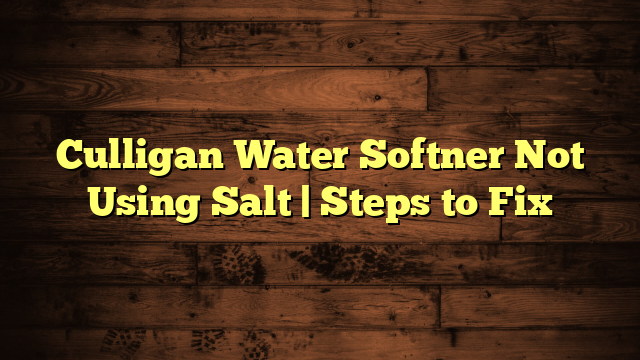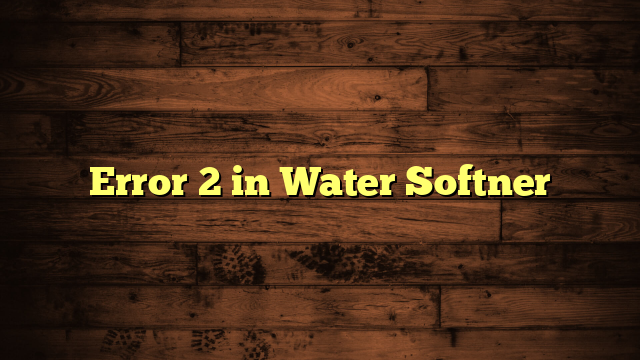Culligan Water Softner Not Using Salt | Steps to Fix
Imagine standing in your kitchen, the water flowing crystal clear, but you notice that your Culligan water softener isn't using salt as it should. It's frustrating when your system doesn't perform at its best, leaving you to wonder what went wrong. You might want to start by checking the salt level in the brine tank, but that's just the tip of the iceberg. There are several steps you can take to troubleshoot this issue effectively, and knowing them could save you time and money. Let's explore what you can do next.
Key Takeaways
- Check the salt level in the brine tank; low levels may prevent the softener from using salt effectively.
- Inspect for salt bridges that can block salt from dissolving properly in the brine tank.
- Examine the control valve for blockages and ensure timer settings are correct for regeneration cycles.
- Clean the injector assembly to remove buildup or clogs that may hinder proper salt usage.
- If issues persist, consider resetting the system or seeking professional help for deeper problems.
Common Symptoms of the Issue
When your Culligan water softener starts acting up, you might notice several common symptoms. One of the most obvious signs is hard water spots on your dishes or fixtures. This points to a potential malfunction in the softening process.
You might also feel that your skin is drier than usual after showering, which could indicate that your water isn't being softened properly. Another symptom to watch for is a salty or metallic taste in your drinking water, suggesting that the softener isn't functioning as it should.
For effective symptom identification, keep an eye on your laundry as well. If clothes feel stiff or look dingy, it could mean your softener is failing.
When troubleshooting, first check for any error messages on your unit's display panel; these can provide essential clues. Furthermore, listen for unusual sounds coming from the system, as they may indicate an underlying issue.
Check the Salt Level
How often do you check the salt level in your Culligan water softener? Keeping an eye on this is essential for peak performance.
If your softener isn't using salt, it could be due to a low salt level. Regularly checking and maintaining the right salt types is a key maintenance tip you shouldn't overlook.
To check the salt level, lift the lid of your brine tank. You should see salt, but if it's below the recommended level, it's time to add more.
Use the appropriate salt type, such as evaporated or solar salt, as each type has its own benefits. Evaporated salt generally contains fewer impurities, while solar salt is often more cost-effective.
If you find the salt level is adequate, but your softener still isn't working properly, then you may need to take into account other issues.
Remember, a well-maintained water softener not only guarantees soft water but also extends the life of your appliance.
Inspect the Brine Tank
Regularly inspecting the brine tank is essential for guaranteeing your Culligan water softener operates efficiently.
Proper brine tank maintenance not only helps in identifying issues early but also guarantees peak salt usage, enhancing your system's performance.
Here are three key aspects to check during your inspection:
- Salt Level: Verify the brine tank has an adequate amount of salt. Low salt levels can hinder regeneration and lead to hard water problems.
- Salt Bridges: Look for any salt bridges, which are hard crusts that form when salt clumps together. These can prevent the salt from dissolving properly, impacting effectiveness.
- Water Level: Check the water level in the tank. It should be above the salt but not overflowing. If the water's too low, it won't effectively dissolve the salt.
Examine the Control Valve
Now that you've inspected the brine tank, it's time to check the control valve.
Start by looking for any blockages that might hinder water flow, and make certain the timer settings are correct to guarantee proper regeneration cycles.
Finally, don't forget to verify that the resin is functioning well, as it's essential for effective water softening.
Check for Blockages
Checking for blockages in your Culligan water softener is vital to maintaining its efficiency, and one of the key components to inspect is the control valve. This valve is essential for regulating water flow, and if it's blocked, it can cause your system to underperform.
Here are some common blockage causes you should look out for:
- Debris Accumulation: Dirt, sand, or mineral buildup can obstruct the valve, restricting flow.
- Improper Installation: If the valve isn't correctly installed, it may not function as intended, leading to blockages.
- Age and Wear: Over time, wear and tear can affect the valve's performance, potentially causing blockages.
Regular maintenance is key to preventing these issues. You should routinely clean the control valve and check for any signs of damage.
Furthermore, consider flushing your system periodically to clear out any buildup. Following these maintenance tips not only enhances performance but also extends the lifespan of your water softener.
If you find persistent blockages despite your efforts, it may be time to consult a professional for further assistance.
Inspect Timer Settings
Often overlooked, inspecting the timer settings on your Culligan water softener can greatly impact its performance. When your system isn't using salt as it should, it may be due to incorrect timer calibration or settings adjustment.
Start by checking if the timer is set to regenerate at the right intervals. If the settings are off, your softener may not know when to recharge, ultimately leading to hard water issues.
Next, verify the time of day set on the timer is correct. If it's not, the regeneration cycle could occur at inconvenient times or not at all. You might also want to confirm that the duration of the regeneration cycle matches the capacity of your water softener.
If you find any discrepancies in the timer settings, adjust them accordingly. Regularly reviewing these settings helps maintain your softener's efficiency and effectiveness.
Don't hesitate to refer to the user manual for specific instructions on your model. Remember, a well-calibrated timer can make all the difference in guaranteeing your Culligan water softener operates smoothly and keeps your water soft.
Verify Resin Functionality
After ensuring the timer settings are correct, the next step is to verify the resin functionality by examining the control valve. The control valve plays an important role in regulating water flow and ensuring the resin is effectively doing its job. If you suspect issues, here's how to check:
- Inspect for Clogs: Look for any debris or buildup in the control valve that could hinder water flow.
- Check the Bypass Valve: Make sure the bypass valve is fully engaged, as a partially open valve can affect resin performance.
- Test for Leaks: Look for any signs of leaks around the control valve, as these could indicate a malfunction.
Regular resin maintenance is essential to keep your water softener running efficiently.
If you notice that the resin isn't functioning as it should, it might be time for resin replacement. Over time, resin beads can become less effective, leading to hard water issues.
By examining the control valve and addressing any concerns, you're taking a significant step toward ensuring your softener operates effectively.
Clean the Injector Assembly
Now that you've checked the control valve, it's time to clean the injector assembly.
First, you'll need to locate the assembly, then carefully disassemble it to inspect the parts for any buildup or damage.
Once you've cleaned everything thoroughly, reassemble the injector properly to guarantee your water softener runs smoothly.
Identify Injector Assembly Location
To keep your Culligan water softener running smoothly, it's essential to locate the injector assembly for cleaning. This assembly plays a significant role in the softening process, so effective injector maintenance is important.
Here's how to identify its location:
- Check the Owner's Manual: Your manual usually contains diagrams and specific locations for the injector assembly.
- Look at the Brine Tank: The injector assembly is often near or connected to the brine tank, so inspecting this area can lead you to it.
- Examine the Control Head: The control head, mounted on top of your softener, typically houses the injector assembly components.
Once you identify the injector assembly, you'll be better equipped for assembly troubleshooting.
Regular cleaning can prevent clogs and guarantee peak performance. Remember, a well-maintained injector assembly is essential for the efficiency of your water softener, so don't overlook this step.
Keeping your system in tip-top shape won't only enhance its longevity but also improve the quality of the water in your home.
Regular checks can save you from bigger issues down the road, making your water softener a reliable companion.
Disassemble and Inspect Parts
Once you've located the injector assembly, it's time to disassemble and inspect its parts for cleaning. Proper disassembly techniques are vital to avoid damaging components. Start by turning off the water supply and unplugging the softener to guarantee safety. Carefully remove the injector assembly cover, taking note of how parts are fitted together for reassembly later.
During your parts inspection, look for clogs, wear, or mineral buildup. Pay special attention to the screen and the injector nozzle, as these are common trouble spots. Use a soft brush or cloth to gently clean any debris without scratching the surfaces.
Here's a quick reference table to guide you through the disassembly and inspection process:
| Step | Action |
|---|---|
| 1. Turn off water | Shut off the water supply to the unit |
| 2. Remove cover | Unscrew and lift the injector cover |
| 3. Inspect parts | Check for clogs and mineral buildup |
| 4. Clean components | Use a brush to clean the injector nozzle |
Clean and Reassemble Properly
Cleaning the injector assembly is essential for guaranteeing your Culligan water softener operates efficiently. Over time, debris can accumulate, leading to performance issues and ineffective softening.
To clean your injector assembly effectively, follow these cleaning techniques:
- Disassemble Carefully: Remove the injector assembly and take care not to damage any components during disassembly. Keep track of all parts to avoid losing anything.
- Use Proper Cleaning Solutions: Rinse the injector assembly with warm, soapy water. For stubborn deposits, consider using a vinegar solution to break down mineral buildup. Confirm all components are thoroughly cleaned.
- Inspect for Wear: While cleaning, check for signs of wear or damage on O-rings and other parts. Replace any worn components to guarantee peak performance.
After cleaning, focus on proper reassembly. Align all parts correctly and tighten securely, but don't over-tighten as this can cause damage.
Once reassembled, run a test cycle to check for leaks or issues. By following these steps, you'll restore your Culligan water softener's efficiency and enjoy the benefits of soft water once more.
Reset the System
Resetting your Culligan water softener is a straightforward process that can resolve various issues, from salt level alerts to system malfunctions.
To begin, locate the control panel on your unit. You'll often find a "Reset" button or a similar option. Pressing this button will initiate your reset methods, which can help your system recalibrate and function correctly again.
If your model doesn't have a dedicated reset button, you might need to unplug the unit for about 10 seconds. This simple act can refresh the system's settings. After plugging it back in, check the display panel for any error codes or messages, as they can guide your system troubleshooting efforts.
Once the softener is reset, it's essential to verify that the salt level is appropriate. Refill it if necessary, and then run a manual regeneration cycle. This step guarantees the resin beads are adequately saturated with salt, promoting peak performance.
If problems persist after resetting and troubleshooting, you might need to explore further options, but often, a simple reset is all it takes to get your Culligan water softener back on track.
When to Call a Professional
Knowing when to call a professional for your Culligan water softener can save you time and frustration.
If you've followed the troubleshooting guide and your system still isn't using salt, it might be time to seek professional services.
Here are three key signs that indicate you should call in an expert:
- Persistent Issues: If you've reset the system and tried various fixes without success, don't hesitate to reach out for help.
- Strange Noises or Leaks: Unusual sounds or visible leaks can signal a more serious problem that requires professional attention.
- Water Quality Problems: If you notice a significant decline in water quality, such as increased hardness or discoloration, it's time to consult a professional.
These situations often indicate underlying issues that DIY fixes mightn't resolve.
By calling a professional, you guarantee that your Culligan water softener gets the expert care it needs, potentially saving you from more extensive repairs later.
Don't let minor problems turn into major headaches; trust the pros when necessary.
Frequently Asked Questions
Can I Use Potassium Chloride Instead of Salt in My Culligan Softener?
Yes, you can use potassium chloride instead of salt in your water softener. It effectively reduces hardness, but check your softener's manual first to verify compatibility. You might notice a difference in performance and cost.
How Often Should I Check My Culligan Water Softener?
Like a gardener tending to delicate blooms, you should check your Culligan water softener every month. Create a maintenance schedule that includes water testing, ensuring your system flourishes and delivers the purest water for your home.
What Are the Benefits of Using a Water Softener?
Using a water softener improves water quality by reducing scale buildup, enhancing appliance efficiency, and softening laundry. Plus, it requires less maintenance, so you'll enjoy cleaner dishes and softer skin with minimal effort.
Is My Water Softener Still Effective Without Salt?
Without salt, your water softener isn't effective. It can't perform its job properly, leading to hard water issues. Regular water softener maintenance is essential for effective softening, so make sure you replenish the salt as needed.
How Do I Know if My Softener Needs Replacing?
To determine if your softener needs replacing, watch for softener lifespan indicators like reduced effectiveness, unusual noises, or leaks. Replacement signs, such as frequent repairs or age over ten years, also suggest it's time for a new unit.
Conclusion
To sum up, if your Culligan water softener isn't using salt, don't panic—you're not alone in this salty saga. By checking the salt level, inspecting the brine tank, and cleaning the injector assembly, you can often resolve the issue yourself. Of course, if you find yourself in a bind, it's okay to call in a professional. After all, who knew that softening water could be such a hard task? Keep your system running smoothly, and enjoy that soft water!







